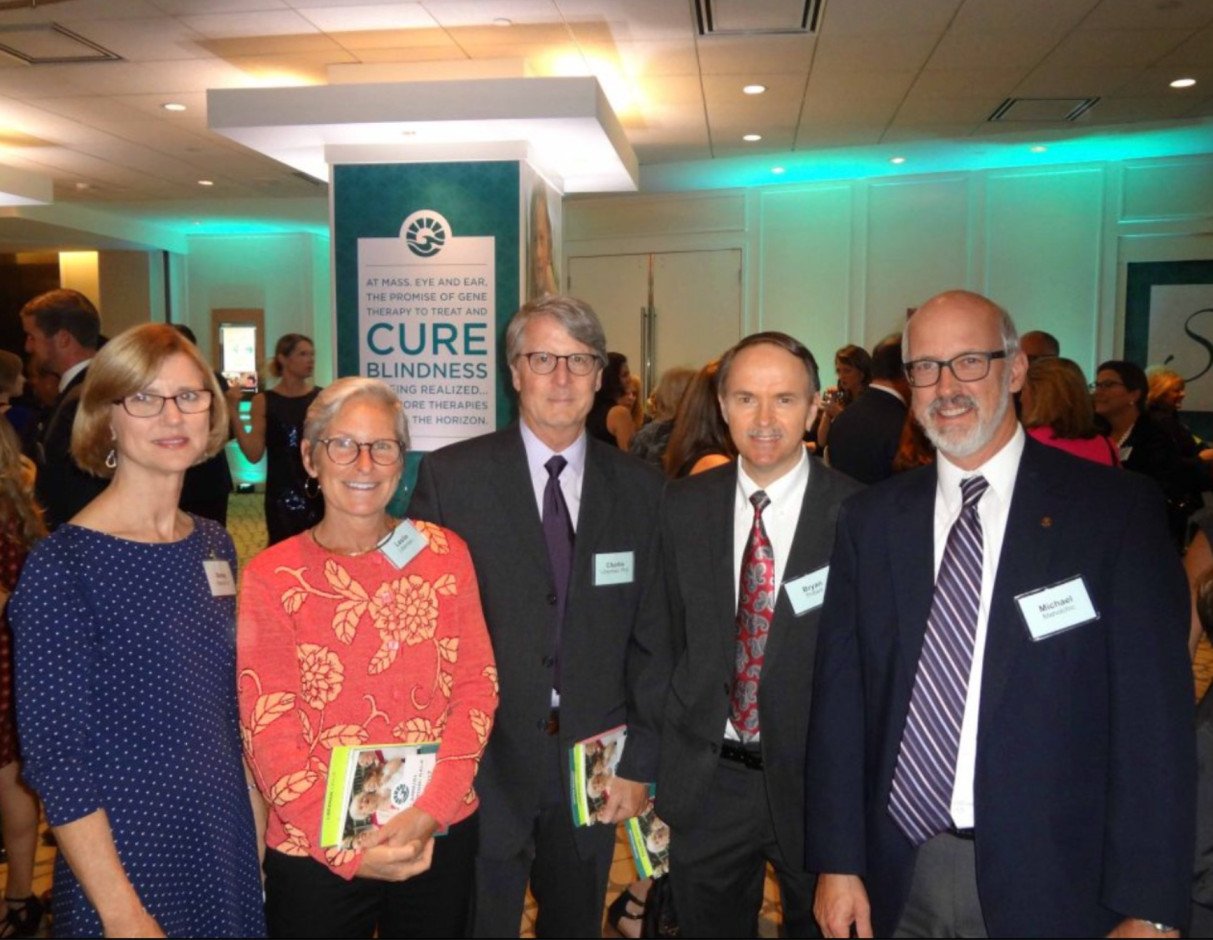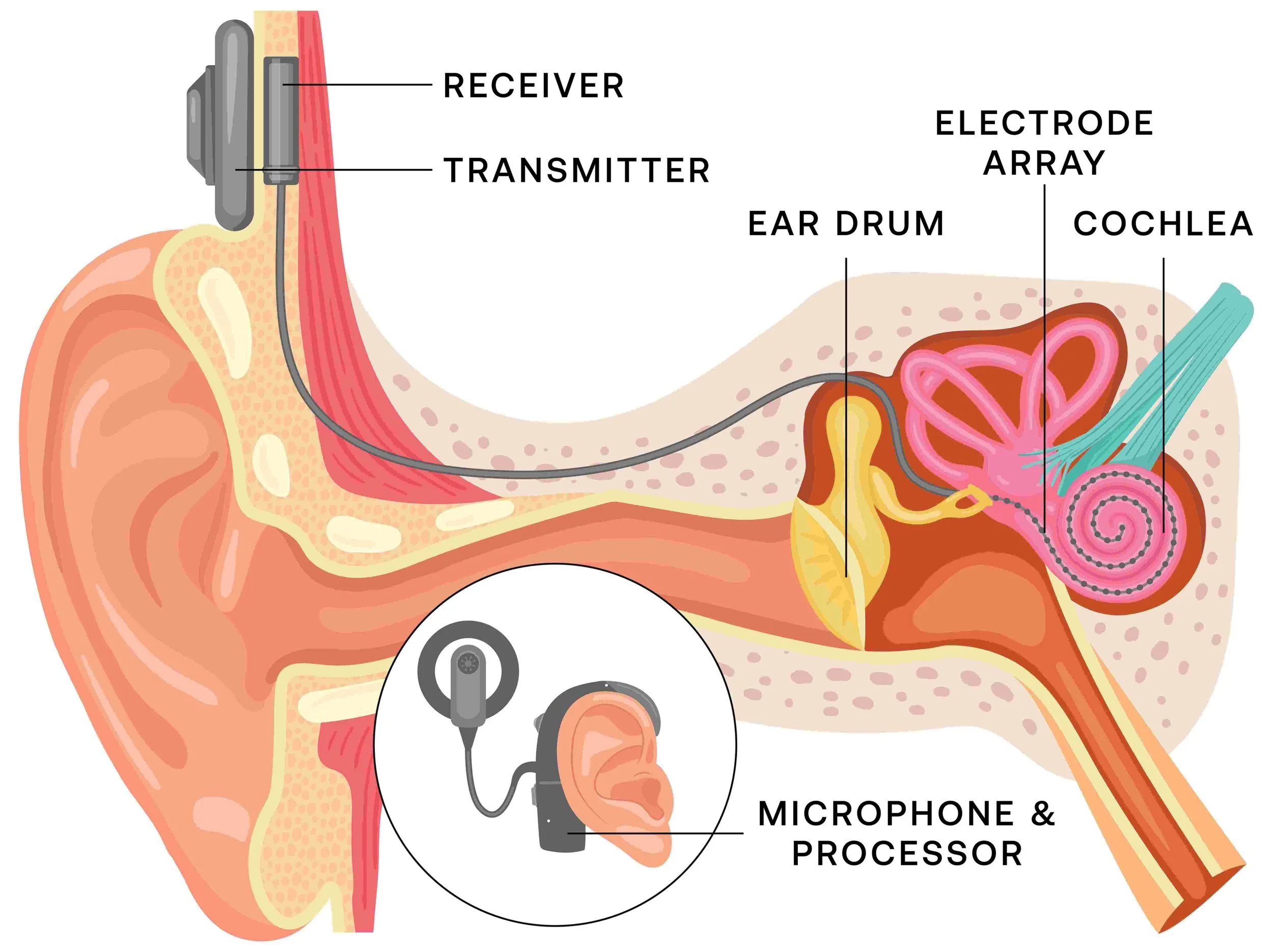By the Board of Hyperacusis Research
We, the board of Hyperacusis Research, are devastated that Bryan Pollard, our founder and shining star, died at age 57 in May. We are taking this opportunity with our partner Hearing Health Foundation to remember Bryan and his contributions to the field of hyperacusis research.
Bryan single-handedly created an entirely new diagnosis in the field of otology—pain hyperacusis—and worked tirelessly on behalf of those who suffered from it. Bryan himself had a noise injury, with symptoms appearing after exposure to a wood chipper removing a tree in his yard.
Bryan Pollard, second from right, with (from left) Betsy Maholchic, Leslie Liberman, Charlie Liberman, Ph.D., and Michael Maholchic, at a Mass Eye and Ear event in 2017. Liberman is head of an otology research lab at Harvard Med School and Mass Eye and Ear, and Michael Maholchic has assumed the presidency of Hyperacusis Research.
Like many with this kind of noise injury, Bryan was unable to get answers from the doctors he saw. Unlike many, he took action, starting the nonprofit Hyperacusis Research in 2011 and becoming the first non-researcher to present at the Association for Research in Otolaryngology conference, prompting researchers to take seriously the condition of being unable to tolerate everyday noise levels without discomfort or pain.
“Bryan was a force of nature,” says Michael Maholchic, who has assumed the presidency of Hyperacusis Research and will carry on the work with the help of the board. This includes our partnership with Hearing Health Foundation and its Emerging Research Grants program.
Bryan not only created a new diagnosis, he had to reverse years of the clinical community’s misunderstanding about hyperacusis. Especially important was his influence on changing the harmful myth that quiet was bad for patients with hyperacusis, and his emphasis on the importance of avoiding setbacks, which result from additional noise exposure. He was always responsive to those who sought his counsel and advice.
He was all too aware that pain—a key component of this kind of noise-induced injury—was barely mentioned. This is why he used “noise-induced pain,” modeled on the term “noise-induced hearing loss,” in order to make the concept of hyperacusis more understandable to everyone in the fields of audiology and otology. He was also aware that the conventional wisdom passed around to people with hyperacusis—that there was no need to protect against noise—was harmful to many.
Patients wanted substantive research into their condition, and Bryan was instrumental in making that happen. He wrote several pieces for professional journals, articles that sufferers found incredibly helpful as they faced a skeptical medical community. In his article “Unraveling the Mystery of Hyperacusis With Pain,” published in ENT & Audiology News in 2019, he noted that the pain component had previously been completely overlooked as part of hyperacusis.
The mission was not just to propel a nascent field forward. Bryan had to turn it around first, and he did so with grace and patience. He emphasized the individual and heterogeneous nature of the condition, with the same noise dose having no effect on some people but causing life-ruining injuries for others.
Bryan preferred to make his points by asking questions rather than spouting information. For example, people would sometimes say they improved because they stopped wearing ear protection. In fact, they stopped wearing ear protection because they improved. “Which is the cause and which is the effect?” he often asked.
His influence on the field was transformational. “Both audiologists—such as myself—and physicians share responsibility for not knowing more about hyperacusis,” says David Eddins, Ph.D., CCC-A, an audiologist and professor at the University of South Florida.
“In my 40-year career, I know of no patient-activist who has influenced the academic and clinical auditory research community in pursuit of knowledge leading to treatment and resolution of his condition as did Bryan,” says Craig Formby, Ph.D., a professor emeritus at the University of Alabama.
Formby adds, “Bryan was a truly unique man from a very humble background. Somehow, while working full-time as an engineer, he would become the most prominent patient-activist and the driving force for promoting research nationally focused on his condition, namely, pain hyperacusis.”
Bryan also influenced the careers of several young researchers who are now focused on this new field. “He had the ability to think broadly about how science and medicine should be integrated to advance treatment,” says Paul Fuchs, Ph.D., a professor at Johns Hopkins University School of Medicine. “Our own basic research benefited directly from his insight and interest.”
Daniel Fink, M.D., credits Bryan for influencing his decision to become a noise activist. He contacted Bryan after seeing him quoted in The New York Times.
“For a non-M.D., non-researcher to somehow influence a surgical subspecialty and get its members to do research on a condition, one which he unfortunately suffered from, is truly remarkable,” says Fink, who developed tinnitus and mild hyperacusis after exposure to loud music at a restaurant on New Year’s Eve.
“Most of the time it takes thousands of people with a condition or symptom or complaint years or even decades to get it recognized as a real medical condition,” Fink adds. “For a relatively rare condition like hyperacusis, what Bryan did was just remarkable.”
An engineer and a scientist, Bryan made a huge difference in the lives of people with hyperacusis and noise injuries. His passing is such a blow to so many, personally and professionally. His insight gave hyperacusis real validity when faced with a slow-moving and conservative medical community that had been relying on outdated and scientifically unfounded information, and that was as a result unaware of the true nature of the condition.
To honor Bryan’s memory, we urge people to donate their ears to science by signing up for the temporal bone registry at Mass Eye and Ear, so that scientists can further their knowledge of hearing disorders. And, of course, we always welcome donations to continue our research and to spread the word about the reality of hyperacusis.
From the board of Hyperacusis Research, we are forever in Bryan’s debt. We love you, Bryan. Rest in peace and silence.
HHF is very grateful to Bryan Pollard for his work bringing attention to hyperacusis and to Hyperacusis Research for their ongoing support of our Emerging Research Grants program in the area of hyperacusis. For the National Temporal Bone, Hearing, and Balance Pathology Resource Registry, see masseyeandear.org/tbregistry. For more, see hyperacusisresearch.org and hhf.org/erg.








Having a hearing loss can be a blessing when in a noisy environment.